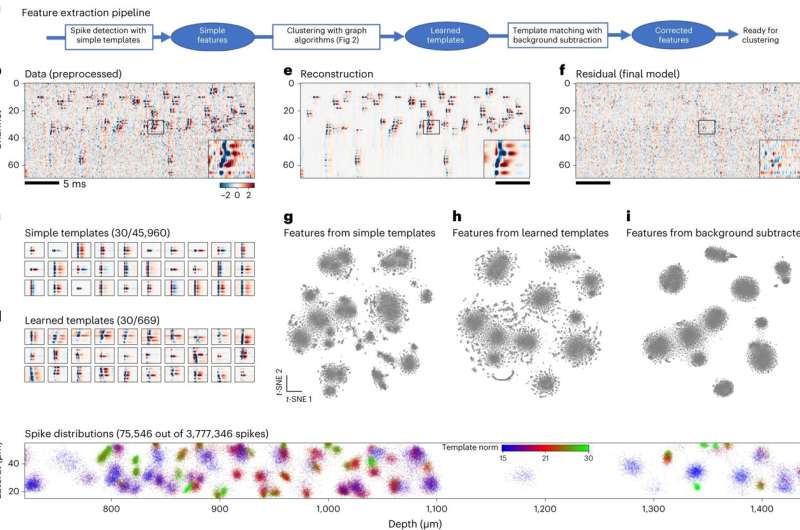
Spike detection and feature extraction. AndSchematic of the spike detection and spike extraction pipeline. bA short segment of pre-processed data over 70 channels and 1000 time points (data from another site16). Insets show an extended section with multiple overlapping spikes. c, Example of simple templates centered on one position on the probe. The templates are repeated at 1536 positions for the Neuropixels probe. dExamples of learned templates centered on different locations on the probe. eData reconstruction in b based on assumed templates and rise times. fThe remainder after subtracting the reconstruction from the data. Mr–I, t-SNE visualization of spiky features from a 40 μm probe segment. Spiky features were extracted using simple templates (Mr) or learned templates without (h) or with (I) background subtraction. j, Spatial distribution of a subset of the final extracted spikes colored by their template norm. Credit: Methods of nature (2024). DOI: 10.1038/s41592-024-02232-7
How can researchers make sense of the mountains of data collected by recording the simultaneous activity of hundreds of neurons? Neuroscientists around the world rely on Kilosort, software that allows them to separate spikes from individual neurons to understand how cells and circuits in the brain work together to process information.
Now, researchers at HHMI’s Janelia Research Campus, led by group leader Marius Pachitariu, have released Kilosort4, an updated version of the popular spike sorting software that has improved processing, requires less manual work, is more accurate and easier to use than the previous version.
“Over the past eight years, I’ve been refining the algorithm to make it more and more human-independent so that people can use it immediately,” Pachitariu says.
Kilosort has become indispensable to many neuroscientists, but it might never have been developed if Pachitariu hadn’t decided he wanted to try something new.
Pachitariu’s PhD work was in computational neuroscience and machine learning, but he yearned to work on more real-world applications and almost left academia for industry after completing his PhD. Instead, Pachitariu opted for a postdoctoral fellowship in the joint laboratory of Kenneth Harris and Matteo Carandini at University College London, where he could do more experimental neuroscience.
The lab was then part of a consortium testing a probe called Neuropixels, developed at HHMI’s Janelia Research Campus. Pachitariu had no idea how to use the probes, which simultaneously record the activity of hundreds of neurons, but he knew how to develop algorithms to keep up with the vast amount of data his lab colleagues were generating.
In the first year of his postdoctoral studies, Pachitariu developed the initial version of Kilosort. The software, which was 50 times faster than previous approaches, allowed the researchers to process millions of data points generated by the Neuropixels probes. Eight years later, the probes and software are a staple of neuroscience labs around the world, allowing researchers to identify and classify the spikes of individual neurons.
In 2017, Pachitariu became a group leader at Janelia, where he and his team seek to understand how thousands of neurons work together to enable animals to think, decide and act. These days, Pachitariu spends most of his time running experiments and analyzing data, but he still finds time to work on improving Kilosort. The recently released Kilosort4 is best-in-class, outperforming other algorithms and correctly identifying even hard-to-detect neurons, according to the researchers.
Pachitariu says it’s much easier to squeeze in work on projects like Kilosort in Janelia than at other institutions where he would have to spend time writing grants and teaching.
“Every now and then I can spend a few months building a new version and writing new code,” he says.
Pachitariu says he also enjoys refining Kilosort, which allows him to use the core skill set he developed during his Ph.D. work.
“I enjoy doing it and I know it’s useful for other people, so that always helps motivate me,” he says.
The work is published in the journal Methods of nature.
More information:
Marius Pachitariu et al, Spike sorting with Kilosort4, Methods of nature (2024). DOI: 10.1038/s41592-024-02232-7
Made possible by the Howard Hughes Medical Institute
Quote: Neuroscientists release state-of-the-art spike sorting software (2024, April 8) Retrieved April 8, 2024 from https://medicalxpress.com/news/2024-04-neuroscientists-state-art-spike-software.html
This document is subject to copyright. Except for fair dealing purposes for private study or research, no part may be reproduced without written permission. The content is provided for informational purposes only.